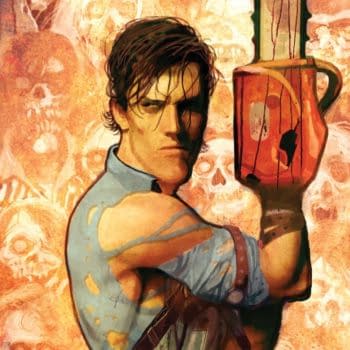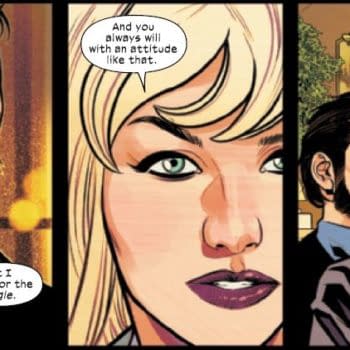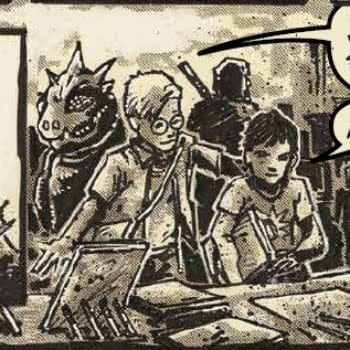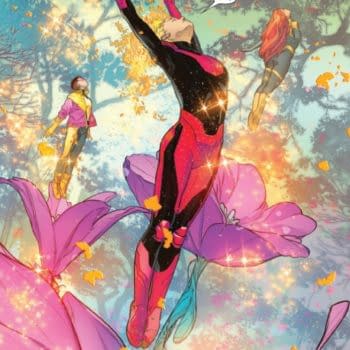Posted in: Comics | Tagged: Alan Moore, Comics, from hell, lost girls, swamp thing
An Appreciation Of Alan Moore, One To Three
Stephen Sonneveld writes;
I. Creation Myths
When reviewing Ingmar Bergman's final film "Saraband" for American television, film critic Richard Roeper remarked that the Swedish director's work existed on another plane, above and apart from anything Hollywood was doing.
The same is true for the comic books penned by Alan Moore, a fact I was happy to rediscover late last year when I finally sat down to read his issues of "Swamp Thing."
I say rediscover because, for better or worse, "Alan Moore" has become a trusted brand noun over the years, not so much a Northampton gent's name.
The same is true of da Vinci, Charlie Chaplin and other artists whose immense talents are taken for granted. The public knows they do great and important work, but few have actually enjoyed any of it. Silly and self-important arguments ensue among the subcultures of bitter tweeds, as though it is at all possible to quantify the genius of Chaplin against the genius of Keaton, Mozart against Beethoven.
No, artists are well-remembered for a reason, and the rest of us, well, we just like the art we like. However, it's nice to bend the spine of Shakespeare every once in a while and see what all the fuss is about.
It was issue #46, "Revelations," for me. That was the tie-in to the world shattering "Crisis on Infinite Earths" maxi-series. Now that I'd heard of. I was too young a comics fan at the time to even have "Swamp Thing" on my radar, but "Crisis" was everywhere. "Crisis" was grand, super-opera; heroes die! crossovers! space battles!
It was by no means a missed opportunity, but compared to "Swamp Thing," frankly, it now seems almost sophomoric. For the tie-in, Moore was tasked with the notion of God wipes his arse with existence and delivered more than just widescreen action sequences, however beautifully rendered. The end result: "Crisis" was about buildings, "Swamp Thing" was about souls.
The first lines of the book are the voice of every storm:
"Something was eating the sky.
"Everyone who's ever hoped to be long dead by doomsday looked up, and the feeling in their stomachs was just as they'd always known it would be.
"It seemed unfair. But then, it had to happen in somebody's lifetime."
Employing Dickens, Moore summarizes the Crisis event elegantly: "It was the best of times, it was the worst of times, and it was all of them at once."
And all this… merely prelude, as occult dick Constantine informs his reluctant squad, "The real crunch is yet to come, after all these fireworks have blown over. That's what we've got to be ready for."
Here, DC is rolling out twelve big issues, endless tie-ins and follow ups, spending millions of dollars in advertising, and Constantine dismisses the mega event for what it was—"fireworks."
In the courage and confidence of his storytelling, the actual Crisis was just a stepping stone for Moore to alight his inner Kirby and rocket beyond all edges. In hero stories, even if the tactile, comfortable place we call a universe accordions in on itself, there is some relief that the afterlife will be a safe place. Moore's masterstroke was to acknowledge that all which is unseen would be imploding and vulnerable, as well—a more horrifying concept I've yet to encounter.
Swamp Thing was enlisted to help save the spiritual plane because, by this point, he was an elemental, a force of nature like unto a god who could travel to Hell in the footsteps of Orpheus and rise again.
From the very onset of his run, Moore saw what comics were and wrote them as he wished they could be. Handed a standard comic book birth (man doused with chemicals gains powers of swamp), Moore justified the character's origin, while completely reinventing it: Alec Holland died in that combustion of chemicals, but the fireball of his death provided the spark of life in the swamp, just as the tumult of our young, volcanic earth somehow created sentience in primordial muck.
Moore famously expressed his dissatisfaction with the post-"Watchman" comic book industry, which only seemed to revel in violence without context, and darkness without ideas. The river of Moore's ink took Swamp Thing down some dark currents, but what made the stories sophisticated was that concepts—such as the comic book origin, such as the Crisis—were pushed to reach new understandings.
In Moore's imagination, familiar werewolf tropes became a gateway to a tragic story of female yearning and liberation in issue #40's "The Curse." Moore drew upon Pagan notions that the soft, nurturing Moon and her cycle were the devine, celestial representation of womanhood and her cycle, and threaded those ancient knowings into moonstruck lupine lore.
The flash and fireworks of Hollywood—that also crept into the comic book industry over the past decade—have their "high-concept" (It's "Die Hard" at a truckstop!) and "mash-up" (Avengers meets ladies basketball!) and the results are projects such as the 2012 film "Prometheus," for instance, which set up the dominos to be an action film with ideas, but settled for being a shoot 'em up with requisite ticking clock and sequel potential.
Science fiction through the lens and pens of Arthur C. Clarke, Stanley Kubrick, Moore and Kirby bring a thoughtfulness—the heart of sophistication—to the muscle, the terror and the awe.
Even today, mercifully years astride from the grim and gritty era, I read the big event books and, more often than not, feel as though the creators didn't really go all the way with their concept, or explore all the facets of it.
With "Swamp Thing" and other writings, Alan Moore truly got to the nature of things.
II. Ripping Yarn
"From Hell" is another Moore opus I had heard about for years, but only recently have read in its entirety. Being a studious comic fanboy back then, I purchased a random issue based on the book's reputation, took it home and couldn't make heads or tails of it.
I was grateful for the collected edition, and the chance to read the Victorian nightmare at once and in full. The morning after I'd finished the book, I promptly removed it my house.
I'm not a superstitious man, but by reading that book, I awoke its palpable presence, and, literally, had to remove it from my home, never to bring it back.
Chapter 10, "The best of all tailors," was where the devil slumbered. It depicts the gruesome scene at 13 Miller's Court on the evening of November 9th, 1888, wherein Jack the Ripper ritualistically fillets Marie Kelly.
Needless to say, the storytelling by Moore and Eddie Campbell was profoundly and effectively disturbing.
In the appendix to the 2006 Top Shelf edition, Moore wrote:
"While no one can profess to know what thoughts went through the mind of whoever was in Marie Kelly's room that night, it seems to me, at least on the level of the killer's own emotional reality, some kind of an Apocalypse transpired. Human experience went to the very edge, there in that sordid little flat, then stepped beyond. The depiction here is as close as I can get to a portrayal of what might have happened that night. In that room. In that mind.
"To be absolutely honest, it's as close as I want to get."
Again, Moore started with a concept, compelled to write "something lengthy on a murder," as he stated in the illustrated appendix, but walked each line of the spider web that spun from it.
In lesser hands—yes, the 2001 movie version—"From Hell" becomes a police procedural, more concerned with unmasking the killer of tarts. Anonymity is, after all, the secret to Jack's endurance; had the Whitechapel killer been caught, tried and hanged, he'd be little more than a horrible footnote known only to seekers of such things.
Under Moore's direction, those five ladies—to whom he dedicates the book—are given life again, and the chance to finally have a mature voice amidst a rich, interweaving narrative, in a field of study where they are usually portrayed as little more than dead girl props.
The collaborators Moore and Campbell, indeed, crafted a great murder tale (sprawling, intriguing, plausible), but were not content to stop at exploring the issues of class within it, or the nature of power propelling it. Many works claim to offer a glimpse inside the mind of a killer, but this is the only work, to my knowledge, that ever sought to understand that deranged mind's transcendence into oblivion.
III. V For Vagina
Art has a way of finding us when we need it, and of Moore's books, "V for Vendetta" was such for me.
I'm not the type who re-reads books, but after reading the "Swamp Thing" issues, I was compelled to revisit V, and it resonated with this version of me as much as it did back then. A few years ago, I tried re-reading "Watchmen" and couldn't get through it. I don't know if it was the book or the reader that had grown beyond the other.
Regardless, I loved the inky artwork of V co-conspirator David Lloyd, and the fact that the story, like "Watchmen," touched the frayed nerve of our era's nuclear anxiety.
Having recently seen the film version of the stage version of "Les Misérables," I was reminded of how much "V for Vendetta" shared that Victor Hugo canvas of intense, personal stories bleeding into collage.
As for V's politics, I appreciate the outrage was real. For that same reason, I was equally glad that the failed neoconservative agenda of the godforsaken W. Bush years was used as the political fuse to ignite the landscape of the 2005 film adaptation. That V's frozen grin immediately became the face of worldwide protesters is a credit to the emotional honesty of both the book and the film.
Whether it's King Arthur or Guy Fawkes, myths stay relevant through reinvention. Whatever the crisis of our times, art finds us when we need it.
In 2006, Alan Moore sat at the campfire to reinvent the legends of Alice in Wonderland, Dorothy from Oz, and Wendy from Neverland. All of those stories concern great adventures that inevitably lead to childhood's end, a theme Moore seized on, not just for his protagonists, but, once again, on the canvas they shared.
The events of "Lost Girls" take place on the eve of the first World War. When I learned of WWI in grammar school, one chilling fact has always remained with me: nearly an entire generation of European men lost their lives to that conflict.
I later learned that some Victorians and Edwardians honestly believed that they had seen the last of war; that they'd cured the world of it.
Meantime, their contemporaries across Europe were infected by an all encompassing anti-royal revolution.
Those revolts brought an end to the age of kings, while the war decimated chivalry, ensuring that the face and fate of conflict would no longer be that of men, but machine; planes, tanks, and guns that could fire so many bullets as to cut a man in half.
Even the fabled Red Baron, he of old world gentry, grew despondent as the war slogged on, seeing it for the faceless, soulless parade of technology it had become. The very planes von Richthofen were flying were already far more advanced than the unreliable clunkers available at the onset of the fighting. By the end of the same small century, planes would no longer need pilots to rain fire upon the earth.
"Lost Girls" isn't the first work to explore this epoch change (the BBC's great 1974 miniseries "Fall of Eagles" is worth a watch), but to do so in the form of erotic literature again speaks to the level of sophistication and surety of storytelling Moore and Melinda Gebbie were working on.
I'd first read of the project in a Wizard Magazine preview, and it sounded like the plot of a porn—Alice, Dorothy and Wendy meet in a hotel and become well met.
The problem with pornography is that it does objectify women. It objectifies everyone because it reduces the human form to abstraction, though the same is true of a Busby Berkeley dance number.
What makes this work literature is that Moore/Gebbie don't divorce the spirit from the flesh.
It is also keenly aware that war is the preferred pornography of Western culture; war, that thing which levels the world to abstraction.
The taboo of sex comes from religions which were/are in the business of self-perpetuation. The best method to ensure that success was/is to control the population. As such, any sexual act not in the service of reproduction is deemed a sin.
This mindfuck continues to foster an unhealthy fear and shame connected to human bodies out of Eden, and is perhaps best exlempified through the myth of Onan, who was smited by no less than God for spilling his seed, not spreading it.
The worst of the poisons polluted from these political machines were—and remain—the subjugation of women and homophobia.
Ironically, of course, even though Judaism, Chritianity and Islam preach peace and love, agents on behalf of all have taken up arms to secure strategic tracts of real estate. Thus the Western dichotomy of lust: warmongers get parades, whoremongers get arrested.
As with other of his books, Moore utilizes concurrent narratives to great effect in "Lost Girls," and Gebbie is more than suited for the schizophrenic artistic task of providing works-within-the-work as diverse as Moore's chameleon writing captures the voices of Oscar Wilde and others.
In these many years removed from "Swamp Thing," however, it is Moore's voice which remains the most effective:
"We hardly spoke, returning to the boat.
"The sun had all but gone, leaving a somber, elegaic light towards the West. No birds were flying overhead…
"There were no birds to fly."














